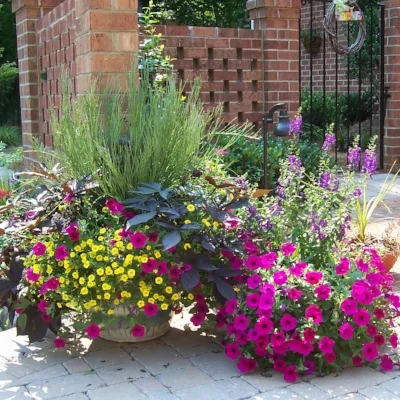A Pox on your Plants: Summer Leaf Diseases
Summer’s heat and humidity are ideal conditions for the development of plant diseases, particularly those that affect leaves. Most are triggered by specific environmental conditions, and have preferred hosts. Many can be prevented or minimized by good cultural practices-good pruning or plant spacing to increase air movement, avoiding getting leaves wet overnight, and proper irrigation and fertilization levels that lead to healthy plants that can fight off diseases. Here are a few summer plant diseases to look out for.
Powdery mildew on pumpkin leaf. Photo: Jeff Kubina (Own work) [Public domain], via Wikimedia Commons
If your plants look like a white powder has appeared in blotches on the leaf, you’re probably dealing with powdery mildew. The “powder” will not rub off easily; it is actually a fungal growth on the leaf. It is rarely fatal on an otherwise healthy plant, but can cause plants to be unattractive and affect plant growth. Some plants notorious for developing powdery mildew are squashes and cucumbers, bee balm, roses, peony, crape myrtle, and dogwood. It develops in warm, humid conditions. Powdery mildew can be somewhat controlled by increasing air circulation with pruning and avoiding overcrowding, by practicing good plant sanitation by removing fallen leaves so they can’t overwinter the spores, by not planting susceptible varieties in shady locations, and by minimizing tender succulent growth (don’t over-fertilize, over-water, or over-prune). Powdery mildew is actually caused by many different fungi that affect specific plants or plant families, so the mildew on your zucchini will not affect your roses, but it may affect your cucumbers. Chemical control on ornamental plants is not absolutely necessary* in many cases as the disease is mostly cosmetic; for very susceptible plants prevention with any number of fungicides is effective, but must be repeated at the interval the label indicates for extended control. Since the disease can weaken vegetables enough to impact yield, preventive treatments with organic controls may be necessary. Fortunately, this is a disease that is well prevented by organic measures, including the odd (yet seemingly effective) milk treatment.
*EDIT: In the case of Impatiens Downy Mildew, prevention is difficult and control is not possible. It is one of the few downy mildews that is completely devastating to the host plant. If seen, affected plants must be removed, bagged and discarded.
Cercospora leaf spot, one of many summer leaf spot diseases. Photo: David B. Langston, University of Georgia, Bugwood.org [CC BY 3.0-us], via Wikimedia Commons
Leaf spots are caused by a multitude of fungal and bacterial pathogens (Alternaria, Cercospora, Cylidrosporium, Septoria and many more). They can be a problem in cool, wet weather during early spring or extended rainy periods. Some, like the one that only affects black-eyed Susan and its relatives, will not spread to plants it does not favor. Others are able to affect a wide range of hosts. Prevention is the best control-be sure leaves are dry overnight and there is good air circulation, keep fallen leaves raked to prevent disease spread and overwintering. Preventive sprays containing mancozeb, fixed copper, or chlorothalonil are effective on a broad range of leaf spots and can be used on susceptible plants, but in many cases spotting is not excessive and environmental conditions may become less favorable for disease spread.
Scale and sooty mold on a Eucalyptus tree. By Bidgee (Own work) [CC-BY-3.0], via Wikimedia Commons
Many insects, particularly aphids and scale, secrete honeydew, a sugary substance that is an ideal growing medium for sooty mold. It does look exactly like soot: a dry, black coating on leaves. While it does not penetrate the leaf surface or feed on plant tissue, a thick coating can reduce the plant’s ability to photosynthesize. This can result in reduced plant vigor, making it susceptible to additional insect and disease pests. The treatment is to control the insect infestation. It is difficult to remove; fortunately the use of horticultural oils & soaps to control the problem insects can soften the coating of sooty mold, causing it to weather off more quickly. For small areas on shiny-leaved plants, a mild soap solution and a rag can work. Otherwise it can take several season to weather off or be covered by new growth.
This leaf issue shows the importance of diagnosing a problem correctly. If you saw this on your Laurels:
Here the disease is active, showing the brown leaf spots as they separate and fall out.
...you might think some insect critter was eating your leaves, and reach for an insecticide. In this case though, the culprit is shothole. An important pest of Laurels, shothole is the result of a fungal or bacterial infection, therefore an insecticide would be useless. The initial infection is brown spots that enlarge, then drop out of the leaf leaving a hole. Multiple holes can join together and give a ragged appearance. Once established, regular treatment is usually necessary. Good air circulation and sanitation (picking up and disposing of fallen leaves in the trash, not a dump or compost pile) can help minimize spread, and plants in sunnier areas may be affected less than plants in shadier locations, but preventive treatment with mancozeb or copper containing fungicides is usually required. The disease is active through all warmer months (April-October) with peak activity in May and September.
Of course there are many other disease pests that may be encountered in the summer garden. If you have a problem that’s not described here, feel free to bring samples to us here at New Garden for identification and treatment options. For all of them, regular inspection of your plants can minimize damage and make control measures more effective.























